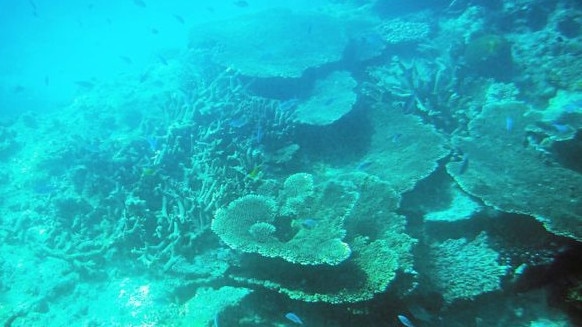Zero at the equator? The so-called climate experts have gone troppo

Last September the usual media suspects got wind of yet another Intergovernmental Panel on Climate Change report. To those familiar, it was obvious from the “fire and brimstone” headlines. No matter how inconsequential, no heatwave, drought, hurricane or flood was missed. This is the customary softening-up period, intended to ensure that when a scary IPCC report lands, politicians will be pushed into taking even more drastic action on “climate change”.
And so it came to pass. Last month, the world’s “leading climate scientists” confirmed we had only 12 years left to keep global warming to a maximum of 1.5C above pre-industrial levels.
Debra Roberts, a co-chairwoman of the working group on impacts, says: “It’s a line in the sand and what it says to our species is that this is the moment and we must act now.” Even half a degree more would significantly worsen the risk of drought, floods, extreme heat and poverty for hundreds of millions of people. Crikey! It’s only three years since Paris, when we were assured 2C could save the planet. What’s next?
At least it’s 10 years longer than Prince Charles gave us. He warned in 2008 that “the world faces a series of natural disasters within 18 months, unless urgent action is taken to save the rainforests”. A decade later, in testimony before the US congress, Roger Pielke Jr, professor of environmental studies in the Centre for Science and Technology Policy Research, University of Colorado, contradicted Charles, saying it was “misleading, and just plain incorrect, to claim that disasters associated with hurricanes, tornadoes, floods or droughts have increased on climate timescales”.
But then in 2011 the International Energy Agency, after “the most thorough analysis yet”, warned that five more years of conventional development would make it impossible to hold global warming to safe levels. The prospects of combating dangerous climate change would be “lost forever”. Well now, in the tradition of ever-receding horizons, the IPCC gives us another 12 years to act.
Catastrophic scenarios aren’t new. In the 1960s and 70s, man-made global cooling was the fashion. In 1971, Stanford University professor Paul Ehrlich predicted: “By the year 2000, the United Kingdom will be simply a small group of impoverished islands, inhabited by some 70 million hungry people.” Ehrlich is now a warmist.
Whom or what to believe? After 50 years of failed predictions, people are reasoning that something other than science is behind this alarmism. And that something is the UN. What else? Its global reach, back corridors and duplicity have allowed it to build an unchallenged, mutually reinforcing $1.5 trillion industry of captive politicians, scientists, journalists, crony capitalists and non-governmental organisation activists bent on globalism through anti-Western sentiment and wealth transfer.
The IPCC’s corrupt hand in this is unmistakeable. Its peer reviewed science turned out to be nothing but veneer. The reviewer of a report on retreating Himalayan glaciers said he was “well aware” it was not peer-reviewed but thought it would encourage policymakers to take action.
We now know Greenpeace and WWF opinion papers have formed the basis of some IPCC reports. A retiring Greenpeace leader confessed to “emotionalising issues” to “bring the public around”. The Climategate dump of emails, which revealed scientists actively colluding to falsify and hide data, demonstrates scientific integrity is arbitrary. Similarly, US whistleblowers have admitted to agencies inventing “warming” trends and confess that “unapproved data sets” were used to sensationalise headlines ahead of the Paris climate conference.
Australian John McLean is the latest climate scientist to shine a light. His audit found the main global temperature set used by climate models exaggerated warming and was not fit for global studies. Fahrenheit temperatures were recorded as Celsius, longitudes and latitudes were in error, crude adjustments were unexplained and place names were misspelled. Tropical islands recorded a monthly average of zero degrees, a place in Romania averaged minus 45C for a month and a site in Colombia for three months recorded an impossible 82C.
For two years the southern hemisphere temperature was estimated from one land-based site in Indonesia and some ship data.
Britain’s Met Office politely responded: “The HadCRUT data set, on which the audit was based, stretches back to 1850 and contains over seven million points of data from in excess of 7500 observation stations on land around the globe together with millions of measurements of sea surface temperature.” Clearly, if science is not the primary focus, near enough is good enough.
The truth will out and, for all the virtue signalling in Paris, a review conducted by the Grantham Research Institute reveals only 16 countries “have reproduced their nationally determined contribution commitments as targets in national laws and policies”. This lack of urgency likely reflects the difference between UN bully pulpit rhetoric and public opinion.
Still, UN globalists will not surrender. From the outset, the purpose of the IPCC was clear. It was to effect a massive wealth transfer on the premise that “climate change and environmental crises are the result of vastly unequal levels of development in the last few centuries” and that the burden of climate change “falls most heavily on poor countries”. The IPCC charter directs it “to understand the scientific basis of risk of human-induced climate change”.
No possible other cause can be considered. So, as there is little empirical evidence to support the anthropogenic thesis, causation must be invented to prevent the UN’s case collapsing. If that fails, there’s always coercion. Bill Nye, US TV’s “science guy”, is already open to climate sceptics being prosecuted as war criminals.
Why not? If jail’s an option, no need to fabricate science.


